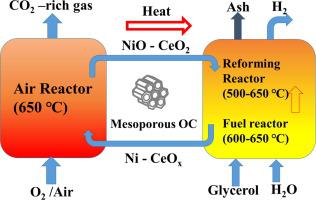Chemical Engineering Journal ( IF 13.3 ) Pub Date : 2020-11-04 , DOI: 10.1016/j.cej.2020.127612 Binlin Dou , Longfei Zhao , Hua Zhang , Kai Wu , Hao Zhang

|
The selection of metal oxides and supports to improve catalytic activity and stability of oxygen carriers (OCs) is crucial for chemical looping steam reforming (CLSR) to hydrogen production. In this study, the Ni-based MCM-41 and SBA-15 OCs with and without CeO2 promoter were prepared by direct synthesis and impregnation methods. The BET, XRD, TEM, ICP-AES, H2-TPR and DSC-TGA were used to analyze the synthesized OCs. Hydrogen production by CLSR using biodiesel byproduct glycerol was studied in a fixed-bed reactor with fuel and air stages. The DSC-TGA experiments were carried out to determine the thermal decomposition of biodiesel byproduct glycerol and the results indicated the exothermic and/or endothermic reactions as a result of secondary reactions and, the main degradation with the mass loss of 85.5 wt% occurred in the stages of 150-500 °C. The mesoporous OCs presented high specific surface area, large pore volume, and uniform pore size. It was found that the NiO and CeO2 in the mesoporous OCs were first reduced by fuels and the reduced OCs was responsible of steam reforming and water gas shift (WGS) to hydrogen production, and hydrogen selectivity was up to 90% using CeNiO/SBA-15. The mesoporous OCs with Ce promoter greatly shortened ‘dead time’ (the reduce time of OCs), and effectively suppressed carbon deposited on OCs. High loading of NiO and CeO2 on SBA-15 improved oxygen transfer and achieved excellent cyclic stability., These findings provide the fundamental understanding and principle of design on the conventional Ni-based OCs with room for further developments in chemical looping process.
中文翻译:

中孔氧气载体通过生物柴油副产物甘油的化学循环蒸汽重整产生可再生的氢气
选择金属氧化物和载体以提高催化活性和氧载体(OCs)的稳定性对于化学循环蒸汽重整(CLSR)到制氢至关重要。在这项研究中,通过直接合成和浸渍方法制备了具有和不具有CeO 2启动子的Ni基MCM-41和SBA-15 OC 。BET,XRD,TEM,ICP-AES,H 2-TPR和DSC-TGA用于分析合成的OC。在具有燃料和空气级的固定床反应器中,研究了使用生物柴油副产物甘油通过CLSR生产氢。进行了DSC-TGA实验以确定生物柴油副产物甘油的热分解,结果表明由于次级反应而发生的放热和/或吸热反应,主要降解发生在质量损失为85.5 wt%的乙醇中。 150-500°C的阶段。中孔OCs具有较高的比表面积,较大的孔体积和均匀的孔径。发现NiO和CeO 2首先通过燃料还原介孔OC中的OC,还原后的OC负责蒸汽重整和将水煤气变换(WGS)转化为氢气,使用CeNiO / SBA-15可使氢气选择性高达90%。带有Ce促进剂的中孔OCs大大缩短了“死时间”(减少OCs的时间),并有效抑制了沉积在OCs上的碳。在SBA-15上高负载NiO和CeO 2改善了氧的传递,并实现了出色的循环稳定性。











































 京公网安备 11010802027423号
京公网安备 11010802027423号